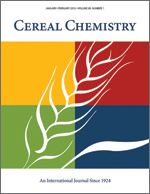
Cereal Chem 50:198 - 209. | VIEW
ARTICLE
Studies of the Differential Staining of Wheat Albumins, Globulins, and Gliadins in Polyacrylamide Gel by Aniline Blue-Black.
M. Minetti, T. Petrucci, S. Cattaneo, F. Pocchiari, and V. Silano. Copyright 1973 by the American Association of Cereal Chemists, Inc.
After gel electrophoresis on polyacrylamide gel and staining of the proteins with aniline blue-black, wheat albumins, globulins, and gliadins give blue-black, blue-green, and reddish-brown bands, respectively. To clarify the nature of this differential staining, we studied the influence of a number of physical and chemical parameters on absorption spectrums of protein bands, as well as the reversibility of the alterations induced by the protein moiety in the aniline blue-black absorption spectrum. We have shown that chromatic differences between albumin and gliadin bands derive from a differential binding to albumins and gliadins of differently colored components of the aniline blue-black. Gliadins bind preferentially some red impurities of the aniline blue-black, whereas in the albumin bands there is a higher percentage of the main blue component of the dye. We suggest that this different behavior of albumins and gliadins is not due to a higher affinity of the red impurities for gliadins as opposed to albumins, but to a lessor tendency of gliadins to coprecipitate the aniline blue-black during the staining process. The blue-green color, distinctive of globulin bands, is mainly due to reversible metachromatic phenomenons induced by globulins in the aniline blue-black spectrum. Since we have induced globulin-like alterations in the aniline blue-black spectrum by adding dehydrating agents (such as salts and strong acids) to a solution of the dye, we concluded that globulin-induced aniline blue-black metachromatism is due to interactions among dye molecules forced to suitable distances after binding to the protein chain.